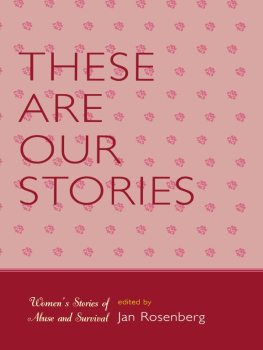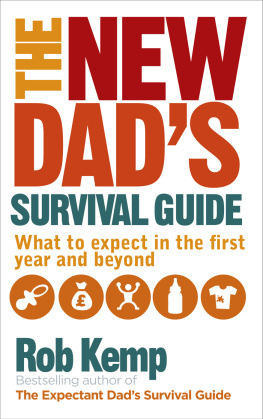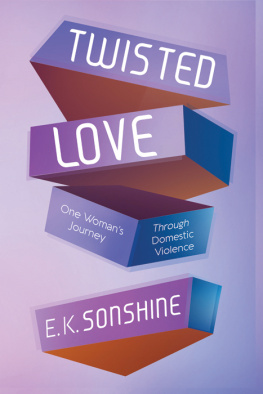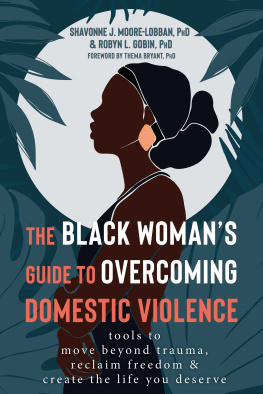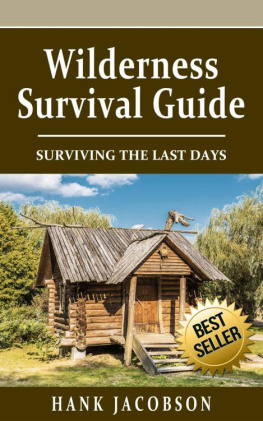THE BATTERED WOMANS SURVIVAL GUIDE

THE
BATTERED
WOMANS
SURVIVAL
GUIDE

BREAKING THE CYCLE

Jan Berliner Statman
Foreword by Sharon Obregon, MSSW
Executive Program Director, The Family Place

Copyright 1990, 1995 by Jan Berliner Statman
All rights reserved.
No part of this book may be reproduced in any form or by any means, including photocopying and use of all electronic devices, without written permission from the publisher.
Published by Taylor Publishing Company
1550 West Mockingbird Lane
Dallas, Texas 75235
Library of Congress Cataloging-in-Publication Data
Statman, Jan Berliner.
The battered womans survival guide: breaking the cycle/Jan Berliner Statman.
p. cm.
ISBN: 978-0-87833-890-0
1. Abused women United States. 2. Abused women services for United States. I. Title.
HV6626.S72 1995
362.8292 dc20
89-20606
CIP
Printed in the United States of America
10 9 8 7 6 5 4 3 2 1
This book is dedicated to all the wonderful men in my life: to the memory of my beloved father, Saul Berliner, whose loving heart and sweet nature knew no boundaries; to my dear husband, Max, whose world could never imagine such evil; and to our sons, Charles Barry and Louis Craig, who are the hope of the future.
And to the special women in my life: to my mother, Sylvia Berliner, who is the most remarkable woman I have ever known; to my brilliant sister, Donna; and to my daughter Sherry Michelle, who is so often perceptive beyond her years.
Contents
Foreword
In the early 1970s it would have taken courage for Jan Berliner Statman to publish The Battered Womans Survival Guide. In all probability she would not have been aware that violence against women was the pervasive social problem that we now know it to be. It would have been so much more practical for her to have written a romantic novel about a hero and heroinethe latter who would have endured captivity, degradation, rejection, and torture because she believed that she was destined for true love.
For more than ten years I have had the opportunity to work with hundreds of battered women who sought refuge and help out of fear for their lives and the lives of their children. Even today, many of those women do not realize that they are battered, even though they have survived years of pain and abuse. Many of them do not realize that violence is not acceptable, that people arent for hurting, and that they are not the cause of the violence.
One out of every four women in this country will experience ongoing, systematic episodes of violence within the context of loving relationships. Those relationships will not be romantic, and many will end in death or mutilation of body or spirit, or both. Society is beginning to realize that relationships are not fairy tales and that a good relationship requires skill, good mental health, and two people who are autonomous and who will continue growing throughout their lifetimes. The longer a woman remains in a relationship in which she is a victim, the harder it will be for her to recover that part of herself which she loses piece by piece. Education, reality, and a commitment to a non-violent society will ensure a better existence for today... but more importantly for the generations of tomorrow.
Sharon Obregon, MSSW
Executive Program Director
The Family Place

Part One

THE BATTERING
RELATIONSHIP
1
The Unreported
Epidemic
She Could Be Someone You Know
She could be your daughter, your sister, your neighbor, your friend. She could be a corporate executive, the saleswoman who sold you your new winter coat, a college professor, or a well-respected surgeon. She could be anyone. She could even be someone you love.
If its hard to believe these women could be battered, keep reading. If someone you know is currently being battered, keep reading. In fact, if you are female or care about someone who is, keep reading.
Despite the popular misconceptions, battering does not happen exclusively to women who live on the other side of the tracks. It does not happen exclusively to poor women or uneducated women. It is not exclusive to urban or rural women, to young or old women, to women of a particular color, race, or ethnicity. Battering happens to women who are single, married, divorced, child-blessed, and childless. Battering occurs everywhere, among every group.
The Extent of the Problem
Statistics indicate that one American woman out of every two will be physically abused at some time in her life by the man she loves and lives with. This means that if you are a woman, you have a 50-50 chance of being abused by your husband, your boyfriend, or your lover. The Bureau of Justice National Crime Survey states that a woman is beaten in her home every 15 seconds.
A study conducted by the March of Dimes indicates that one of every twelve women is battered while she is pregnant. Battered women are four times more likely to have low birthweight babies and are twice as likely to miscarry when compared with normal mothers. In fact, battering becomes increasingly frequent during pregnancy, when there are small children in the home, and when the children of the family become teenagers. It is a learned behavior; sons often follow their fathers examples and beat their mothers and ultimately their wives.
Councils on Family Violence provide alarming statistics. Seventy percent of all emergency room assault cases are women. Twenty percent of all hospital emergency room visits by women are attributed to beatings. Battering is the single most significant cause of womens injuries, claiming more lives than muggings, rapes, or automobile accidents. Half of Americas women are safer on the streets than they are in the comfort of their own homes. They are in greater danger of assault, violence, injury, and murder from members of their families than from strangers.
Twenty-five percent of all murders occur in the home and involve family members. Two thousand to four thousand battered women are beaten to death each year. A 1983 FBI Uniform Crime Report indicates that nearly one-third of female homicide victims are killed by their husbands or boyfriends. Ten percent of the men who are murdered in America each year are killed by their female partners acting in self-defense.
Councils on Family Violence are alarmed by how widespread the problem is. And although the statistics are shocking, they do not even begin to reveal the whole story. It is hard to know the exact figures since an estimated eighty percent of the cases of domestic violence go unreported because the battered women are ashamed, are mistakenly protecting their abusers, or are fearful of reprisals.


